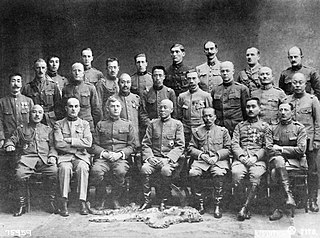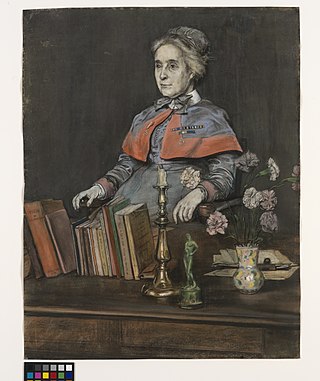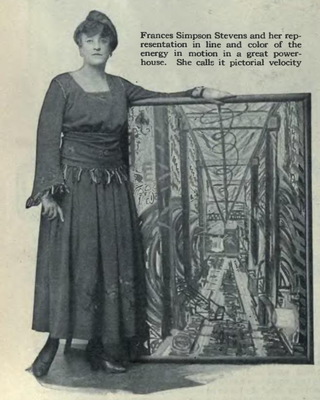Florence Farmborough FRGS was an author, photographer, nurse, teacher and university lecturer.
Florence Farmborough FRGS was an author, photographer, nurse, teacher and university lecturer.
Florence Farmborough, who was the fourth of six children, [1] was born and grew up in Buckinghamshire. [2] In 1908 she went to work as a governess for a family in Kiev, then part of Russia. [3] Two years later she moved to Moscow, where she was employed as English tutor to the two daughters of Pavel Sergeyvich Usov, a distinguished heart surgeon. [4]
On the outbreak of the Great War in 1914, she qualified and worked as a Red Cross nurse with the Imperial Russian army, and saw service at both the Galician and the Romanian Fronts. During her time as a nurse she kept a diary and habitually took a large plate camera around with her. She would develop and print her plates while encamped with the forces. [5] Extracts from the diaries were eventually used as the source material for her book, Nurse at the Russian Front, published in 1974.
She also worked as a reporter for The Times and for BBC Radio. Following the October Revolution and the disbandment of her Red Cross unit, she returned to England in 1918, travelling via Siberia, Vladivostok and the US, and crossing the Pacific on the same ship as Maria Bochkareva. [6] During and after this journey she wrote a number of articles for The Times, which were based on what she had witnessed and experienced in Russia in the aftermath of the Bolshevik coup. [7] She contributed a number of chapters on the peoples of Eastern Europe to "Peoples of All Nations" edited by J.A.Hammerton. [8]
After returning to Britain, Miss Farmborough was elected a Fellow of the Royal Geographical Society. [9]
In 1926 she was appointed as a university lecturer in English in Valencia, Spain. During the Spanish Civil War (1936-1939), Farmborough, who held strong anti-communist opinions, allied with the Nationalists. She worked as a newsreader on Spanish National Radio, broadcasting daily news bulletins in English. [10] She later returned to England and worked for the Women's Voluntary Service during the Battle of Britain, becoming particularly involved in the rehabilitation of Spanish-speaking Gibraltarians.
Later she spent four years as a government censor in Jamaica, checking correspondence to and from South America. She made her home at Sompting near Worthing, Sussex. She gave Russian lessons at her home to pupils from Worthing High School for Boys. Later she moved to Newton Abbot. She made a return visit to Russia in 1962, and visited the Holy Land in 1966. [11]
In 1974, the year in which her First World War diaries were published, she was the subject of a programme English Nurse with the Tsar's Army in the BBC Television documentary series Yesterday's Witness . She was also awarded Honorary Life Membership of the British Red Cross. By this time she was living in a retirement home in Cheshire, although the final part of her life was spent at the home of her nephew. [12]
The idea of publishing a book based on her 1914–18 diaries and photographs, which had been carefully preserved by her sister Margaret, [13] came as a result of an exhibition she gave of her Russian memorabilia [14] at Heswall in April 1971. She declined the services of a ghost writer and, working daily from morning until night over a period of thirteen months, she prepared her manuscript entirely by herself, producing over 400,000 words. By her own admission, that was "much too much", and in the event her publisher cut "almost half of it". [11]
Florence Farmborough died in 1978, aged 91. She never married.
A substantial proportion of her photographs are held by the Imperial War Museum, in the Florence Farmborough collection. [15]

The Russian Civil War was a multi-party civil war in the former Russian Empire sparked by the overthrowing of the social-democratic Russian Provisional Government in the October Revolution, as many factions vied to determine Russia's political future. It resulted in the formation of the Russian Socialist Federative Soviet Republic and later the Union of Soviet Socialist Republics in most of its territory. Its finale marked the end of the Russian Revolution, which was one of the key events of the 20th century.

Alexandra Feodorovna, Princess Alix of Hesse and by Rhine at birth, was the last Empress of Russia as the consort of Emperor Nicholas II from their marriage on 26 November [O.S. 14 November] 1894 until his forced abdication on 15 March [O.S. 2 March] 1917. A favourite granddaughter of Queen Victoria of the United Kingdom, she was, like her grandmother, one of the most famous royal carriers of haemophilia and bore a haemophiliac heir, Alexei Nikolaevich, Tsarevich of Russia. Her reputation for encouraging her husband's resistance to the surrender of autocratic authority and her known faith in the Russian mystic Grigori Rasputin severely damaged her popularity and that of the Romanov monarchy in its final years. She and her immediate family were all murdered while in Bolshevik captivity in 1918, during the Russian Revolution. In 2000, the Russian Orthodox Church canonized her as Saint Alexandra the Passion Bearer.

The Czechoslovak Legion were volunteer armed forces comprised predominantly of Czechs and Slovaks fighting on the side of the Entente powers during World War I and the White Army during the Russian Civil War until November 1919. Their goal was to win the support of the Allied Powers for the independence of Lands of the Bohemian Crown from the Austrian Empire and of Slovak territories from the Kingdom of Hungary, which were then part of the Austro-Hungarian Empire. With the help of émigré intellectuals and politicians such as the Czech Tomáš Garrigue Masaryk and the Slovak Milan Rastislav Štefánik, they grew into a force over 100,000 strong.

María Leontievna Bochkareva was a Russian soldier who fought in World War I and formed the Women's Battalion. She was the first Russian woman to command a military unit.

The Allied intervention in the Russian Civil War consisted of a series of multi-national military expeditions that began in 1918. The initial impetus behind the interventions was to secure munitions and supply depots from falling into the German Empire's hands, particularly after the Bolsheviks signed the Treaty of Brest-Litovsk, and to rescue the Allied forces that had become trapped within Russia after the 1917 October Revolution. After the Armistice of 11 November 1918, the Allied plan changed to helping the White forces in the Russian Civil War. After the Whites collapsed, the Allies withdrew their forces from Russia by 1925.

Princess Maria of Greece and Denmark was a daughter of King George I of Greece and his wife Grand Duchess Olga Constantinovna of Russia. She was a sister of King Constantine I of Greece and a first cousin of Tsar Nicholas II of Russia and King George V of the United Kingdom.

The Voluntary Aid Detachment (VAD) was a voluntary unit of civilians providing nursing care for military personnel in the United Kingdom and various other countries in the British Empire. The most important periods of operation for these units were during World War I and World War II. Although VADs were intimately bound up in the war effort, they were not military nurses, as they were not under the control of the military, unlike the Queen Alexandra's Royal Army Nursing Corps, the Princess Mary's Royal Air Force Nursing Service, and the Queen Alexandra's Royal Naval Nursing Service. The VAD nurses worked in field hospitals, i.e., close to the battlefield, and in longer-term places of recuperation back in Britain.

Zhemchug was the second of the two-vessel Izumrud class of protected cruisers built for the Imperial Russian Navy. She was sunk during World War I by the German light cruiser Emden in the Battle of Penang in 1914.

The Russian Civil War spread to the east in May 1918, with a series of revolts along the route of the Trans-Siberian Railway, on the part of the Czechoslovak Legion and officers of the Russian Army. Provisional anti-Bolshevik local governments were formed in many parts of Siberia and other eastern regions during that summer. The Red Army mounted a counter-offensive in the autumn, and in 1919 defeated the White commander Aleksandr Kolchak in Siberia. Smaller-scale conflicts in the region went on until 1923.

The Siberian intervention or Siberian expedition of 1918–1922 was the dispatch of troops of the Entente powers to the Russian Maritime Provinces as part of a larger effort by the western powers, Japan, and China to support White Russian forces and the Czechoslovak Legion against Soviet Russia and its allies during the Russian Civil War. The Imperial Japanese Army continued to occupy Siberia even after other Allied forces withdrew in 1920.

Women in World War I were mobilized in unprecedented numbers on all sides. The vast majority of these women were drafted into the civilian work force to replace conscripted men or to work in greatly expanded munitions factories. Thousands served in the military in support roles, and in some countries many saw combat as well.

Princess Nina Georgievna of Russia,, was the elder daughter of Grand Duke George Mikhailovich and Grand Duchess Maria Georgievna of Russia. A great-granddaughter of Tsar Nicholas I of Russia, she left her native country in 1914, before World War I finished her education in England and spent the rest of her life in exile. In London in 1922, she married Prince Paul Chavchavadze, a descendant of the last king of Georgia. They had one child, Prince David Chavchavadze, born there two years later. In 1927 the family of three moved to the United States and settled in New York. In 1939 they bought a home in Wellfleet, Massachusetts. Princess Nina was an artist, her husband worked as an author; he wrote five books and translated several others. Their son, Prince David Chavchavadze, served with the U.S. Army during World War II and, thanks in part to his knowledge of Russian, eventually became a CIA officer. After his retirement, he wrote his memoirs and published those of his grandmother, Grand Duchess George, as well as a book about the grand dukes of Russia.

The Canadian Siberian Expeditionary Force (French: Corps expéditionnaire sibérien) (also referred to as the Canadian Expeditionary Force (Siberia) or simply the C.S.E.F.) was a Canadian military force sent to Vladivostok, Russia, during the Russian Revolution to bolster the allied presence, oppose the Bolshevik Revolution and attempt to keep Russia in the fight against Germany. Composed of 4,192 soldiers and authorized in August 1918, the force returned to Canada between April and June 1919. The force was commanded by Major General James H. Elmsley. During this time, the C.S.E.F. saw little fighting, with fewer than 100 troops proceeding "up country" to Omsk, to serve as administrative staff for 1,500 British troops aiding the anti-Bolshevik White Russian government of Admiral Alexander Kolchak. Most Canadians remained in Vladivostok, undertaking routine drill and policing duties in the volatile port city.

The Japanese Siberian Intervention of 1918–1922 was the dispatch of Japanese military forces to the Russian Maritime Provinces as part of a larger effort by western powers and Japan to support White Russian forces against the Bolshevik Red Army during the Russian Civil War. The Japanese suffered 1,399 killed and another 1,717 deaths from disease. Japanese military forces occupied Russian cities and towns in the province of Primorsky Krai from 1918 to 1922.

Dame Sidney Jane Browne, was the first appointed Matron-in-Chief of the newly formed Queen Alexandra's Imperial Military Nursing Service (QAIMNS). After she retired from the QAIMNS she was appointed as Matron-in-Chief of the Territorial Force Nursing Service. Browne was appointed a Dame Grand Cross of the Order of the British Empire in 1919 and, in 1922, she became the first President of the Royal College of Nursing, a post she held until 1925.

Nicholas II or Nikolai II was the last Emperor of Russia, King of Poland and Grand Duke of Finland from 1 November 1894 until his abdication on 15 March 1917. During his reign, Nicholas gave support to the economic and political reforms promoted by his prime ministers, Sergei Witte and Pyotr Stolypin. He advocated modernisation based on foreign loans and close ties with France, but resisted giving the new parliament major roles. Ultimately, progress was undermined by Nicholas's commitment to autocratic rule, strong aristocratic opposition and defeats sustained by the Russian military in the Russo-Japanese War and World War I. By March 1917, public support for Nicholas had collapsed and he was forced to abdicate, thereby ending the Romanov dynasty's 304-year rule of Russia (1613–1917).

The revolt of the Czechoslovak Legion comprised the armed actions of the Czechoslovak Legion in the Russian Civil War against Bolshevik authorities, beginning in May 1918 and persisting through evacuation of the Legion from Siberia to Europe in 1920. The revolt, occurring in Volga, Ural, and Siberia regions along the Trans-Siberian Railway, was a reaction to a threat initiated by the Bolsheviks partly as a consequence of the Treaty of Brest-Litovsk. One major secondary consequence of victories by the Legion over the Bolsheviks was to catalyze anti-Bolshevik activity in Siberia, particularly of the Committee of Members of the Constituent Assembly, and to provide a major boost for the anti-Bolshevik or White forces, likely protracting the Russian Civil War.

Frances Simpson Stevens was an American painter, who is best remembered as one of the few Americans to directly participate in the Futurist Movement. Stevens was also one of the artists who exhibited at the landmark show Armory Show in New York City. The show included her oil painting Roof tops of Madrid ($200).

Marina Yurlova was a Russian child soldier and author. She fought in World War I and later in the Russian Civil War on the side of the anti-communist White movement. Wounded several times, she won the Russian Cross of Saint George for bravery three times. She eventually made her way to Vladivostok, then to Japan and finally to the USA, where she performed as a dancer.

Dame Ethel Hope Becher was a British nurse who served as the War Office matron-in-chief of the Queen Alexandra's Royal Army Nursing Corps from 1910 to 1919, including World War I.